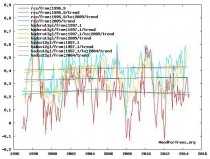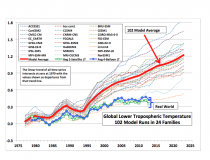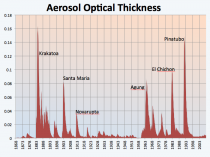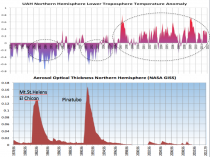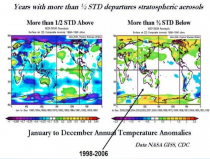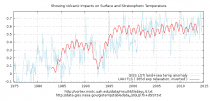The pause is now widely accepted and the climate models are failing.
So they have come up with 66 reasons to date as to why the models are failing instead of that they have given greenhouse gases credit for controlling climate when natural factors are the real drivers.
The latest is that small volcanoes are acting collectively to produce a veil of sulfate aerosols to block radiation. Of course is is well known that the number of global volcanoe remains about the same. Ash and sulfat aerosols from small volcanoes gets precipitated out in a few weeks. The big volcanoes that shoot to 80,000 to 120,000 feet of higher are the climate driver events. In the stable high atmosphere the aerosols spread around the globe and have a lifetime of a few years instead of a few weeks.
See the big ones here on this graph from Hansen’s old group at NASA.
See how the big eruptions of Pinatubo and El Chichon cooled the globe by up to 0.5C for several years. If anything the lack of volcanoes may have contributed to the warming after 1995 when the volcanic efects diminished.
When I did a correlation with temperatues in years with aerosol levels more 0.5 STD above normal and 0.5 STD below normal, I found the expected ressult of cooling when the aerosols were high and warming when low.
Here is Anthony Watts post on the paper subjecting the small eruoption may be responsible for failed models.
Anthony Watts November 19, 2014
Small volcanic eruptions could be slowing global warming
From the AGU: WASHINGTON, DC
Small volcanic eruptions might eject more of an atmosphere-cooling gas into Earth’s upper atmosphere than previously thought, potentially contributing to the recent slowdown in global warming, according to a new study.
Scientists have long known that volcanoes can cool the atmosphere, mainly by means of sulfur dioxide gas that eruptions expel. Droplets of sulfuric acid that form when the gas combines with oxygen in the upper atmosphere can remain for many months, reflecting sunlight away from Earth and lowering temperatures. However, previous research had suggested that relatively minor eruptions those in the lower half of a scale used to rate volcano “explosivity” do not contribute much to this cooling phenomenon.
Now, new ground, air and satellite measurements show that small volcanic eruptions that occurred between 2000 and 2013 have deflected almost double the amount of solar radiation previously estimated. By knocking incoming solar energy back out into space, sulfuric acid particles from these recent eruptions could be responsible for decreasing global temperatures by 0.05 to 0.12 degrees Celsius (0.09 to 0.22 degrees Fahrenheit) since 2000, according to the new study accepted to Geophysical Research Letters, a journal of the American Geophysical Union.
These new data could help to explain why increases in global temperatures have slowed over the past 15 years, a period dubbed the ‘global warming hiatus,’ according to the study’s authors.
The warmest year on record is 1998. After that, the steep climb in global temperatures observed over the 20th century appeared to level off. Scientists previously suggested that weak solar activity or heat uptake by the oceans could be responsible for this lull in temperature increases, but only recently have they thought minor volcanic eruptions might be a factor.
Climate projections typically don’t include the effect of volcanic eruptions, as these events are nearly impossible to predict, according to Alan Robock, a climatologist at Rutgers University in New Brunswick, N.J., who was not involved in the study. Only large eruptions on the scale of the cataclysmic 1991 Mount Pinatubo eruption in the Philippines, which ejected an estimated 20 million metric tons (44 billion pounds) of sulfur, were thought to impact global climate. But according to David Ridley, an atmospheric scientist at the Massachusetts Institute of Technology in Cambridge and lead author of the new study, classic climate models weren’t adding up.
“The prediction of global temperature from the [latest] models indicated continuing strong warming post-2000, when in reality the rate of warming has slowed,” said Ridley. That meant to him that a piece of the puzzle was missing, and he found it at the intersection of two atmospheric layers, the stratosphere and the troposphere- the lowest layer of the atmosphere, where all weather takes place. Those layers meet between 10 and 15 kilometers (six to nine miles) above the Earth.
Traditionally, scientists have used satellites to measure sulfuric acid droplets and other fine, suspended particles, or aerosols, that erupting volcanoes spew into the stratosphere. But ordinary water-vapor clouds in the troposphere can foil data collection below 15 km, Ridley said. :The satellite data does a great job of monitoring the particles above 15 km, which is fine in the tropics. However, towards the poles we are missing more and more of the particles residing in the lower stratosphere that can reach down to 10 km.”
To get around this, the new study combined observations from ground-, air- and space-based instruments to better observe aerosols in the lower portion of the stratosphere.
Four lidar systems measured laser light bouncing off aerosols to estimate the particles’ stratospheric concentrations, while a balloon-borne particle counter and satellite datasets provided cross-checks on the lidar measurements. A global network of ground-based sun-photometers, called AERONET, also detected aerosols by measuring the intensity of sunlight reaching the instruments. Together, these observing systems provided a more complete picture of the total amount of aerosols in the stratosphere, according to the study authors.
Including these new observations in a simple climate model, the researchers found that volcanic eruptions reduced the incoming solar power by - 0.19 plus/minus 0.09 watts of sunlight per square meter of the Earth’s surface during the ‘global warming hiatus’, enough to lower global surface temperatures by 0.05 to 0.12 degrees Celsius (0.09 to 0.22 degrees Fahrenheit). By contrast, other studies have shown that the 1991 Mount Pinatubo eruption warded off about three to five watts per square meter at its peak, but tapered off to background levels in the years following the eruption. The shading from Pinatubo corresponded to a global temperature drop of 0.5 degrees Celsius (0.9 degrees Fahrenheit).
Robock said the new research provides evidence that there may be more aerosols in the atmosphere than previously thought. “This is part of the story about what has been driving climate change for the past 15 years,” he said. “It’s the best analysis we’ve had of the effects of a lot of small volcanic eruptions on climate.”
Ridley said he hopes the new data will make their way into climate models and help explain some of the inconsistencies that climate scientists have noted between the models and what is being observed.
Robock cautioned, however, that the ground-based AERONET instruments that the researchers used were developed to measure aerosols in the troposphere, not the stratosphere. To build the best climate models, he said, a more robust monitoring system for stratospheric aerosols will need to be developed.
Greg Goodman’s comments on WUWT make more sense.
No, this counter-intuitive volcano argument has already been tried. Excuse no. 8 IIRC ![]()
I already commented on this today in Willis’ thread.
The haitus is caused by the LACK of volcanoes because it was the volcanoes that caused the late 20th warming in the first place.
Stratospheric cooling :
Surface warming:
The sulphuric acid reacts not just “oxygen” O2 but ozone : O3. Ozone blocks UV , so less UV is one cause of warming. Sorry UN, none of this has to do with CFCs the Montreal protocol as can be seem from first plot. CFCs have not been bouncing up and down in time with major volacanic eruptions.
There’s more than just the ozone, but if they want to talk about ozone it’s in the stratosphere where it counts, not at 15km.
At least they working with real data but the claimed excuse for the pause is just more maybe, could-be pseudo-science.





